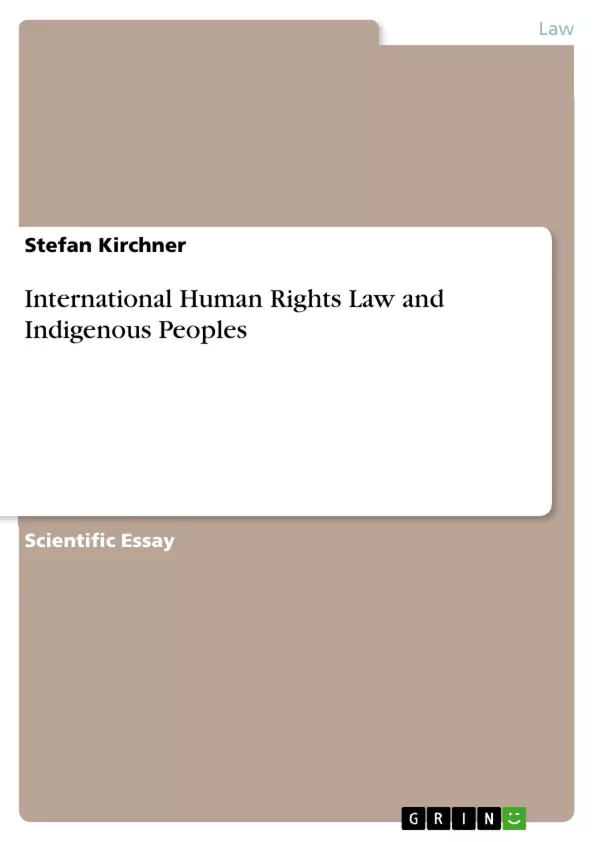How does general international human rights law protect indigenous peoples? After all, the Universal Declaration of Human Rights (UDHR) remains silent on the issue. But the UDHR formed the fundament for the creation of the International Covenant on Civil and Political Rights (ICCPR) and the International Covenant on Economic Social and Cultural Rights (ICESCR), which share a common Article 1, which protects indigenous livelihoods.
Article 1 (2) ICCPR / ICESCR is a reminder of the right to self-determination of peoples and while there is some debate as to whether this is a subjective right of peoples in relation to states or merely a legal principle and if it also applies to indigenous peoples, Article 1 ICCPR / ICESCR is a reminder of the continued relevance of indigenous sovereignty. This essay looks at how international human rights law can be utilized to protect indigenous peoples from the practical human rights law perspective.
Inhaltsverzeichnis (Table of Contents)
- International Covenant on Civil and Political Rights
- Convention on the Elimination of All Forms of Racial Discrimination
- European Convention on Human Rights
Zielsetzung und Themenschwerpunkte (Objectives and Key Themes)
This text examines the protection of indigenous peoples under international human rights law, focusing on the intersection of self-determination and the rights of minorities. The text explores the limitations of the Universal Declaration of Human Rights (UDHR) in addressing indigenous issues and investigates how international conventions, particularly the International Covenant on Civil and Political Rights (ICCPR) and the International Covenant on Economic, Social and Cultural Rights (ICESCR), contribute to the protection of indigenous rights.
- The right to self-determination of indigenous peoples under international law
- The application of Article 1 of the ICCPR/ICESCR to indigenous peoples
- The significance of Article 27 of the ICCPR in safeguarding cultural rights of minorities
- The distinction between the right to self-determination and the rights of minorities under international law
- The importance of respecting the self-identification and choices made by indigenous peoples
Zusammenfassung der Kapitel (Chapter Summaries)
- International Covenant on Civil and Political Rights: This chapter explores the applicability of the International Covenant on Civil and Political Rights (ICCPR) to the protection of indigenous peoples. It analyzes Article 1 of the ICCPR, emphasizing the right to self-determination and its implications for indigenous sovereignty. The chapter also examines the relationship between self-determination and colonial contexts, drawing comparisons between historical colonial situations and the contemporary experiences of indigenous peoples.
- Convention on the Elimination of All Forms of Racial Discrimination: This chapter discusses the relevance of the Convention on the Elimination of All Forms of Racial Discrimination in addressing the rights of indigenous peoples. It explores the Convention's provisions relating to racial discrimination and its potential to combat prejudice and discrimination against indigenous communities. The chapter may examine the Convention's limitations in fully addressing the unique challenges faced by indigenous populations.
- European Convention on Human Rights: This chapter examines the role of the European Convention on Human Rights in safeguarding the rights of indigenous peoples within Europe. It may focus on specific articles of the Convention that are particularly relevant to indigenous issues, such as the right to culture and language. The chapter could also discuss the implementation of the Convention in relation to indigenous communities and the challenges faced by indigenous peoples in asserting their rights under this framework.
Schlüsselwörter (Keywords)
This work centers on the intersection of international human rights law, indigenous rights, self-determination, and minority rights. Key concepts include: Article 1 of the ICCPR/ICESCR, Article 27 of the ICCPR, indigenous sovereignty, cultural rights, self-identification, and the protection of indigenous communities.
- Citar trabajo
- Stefan Kirchner (Autor), 2015, International Human Rights Law and Indigenous Peoples, Múnich, GRIN Verlag, https://www.grin.com/document/313104



